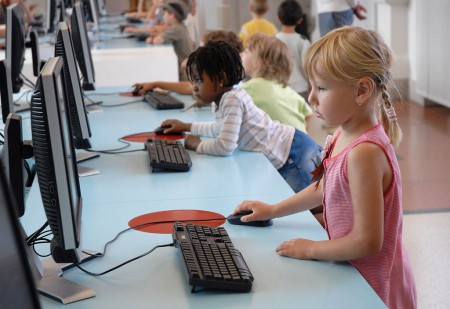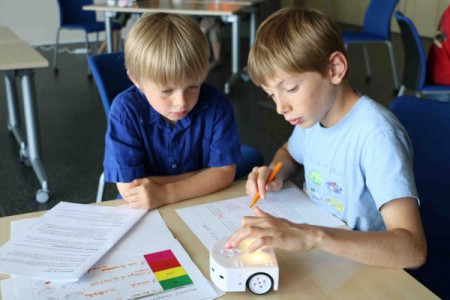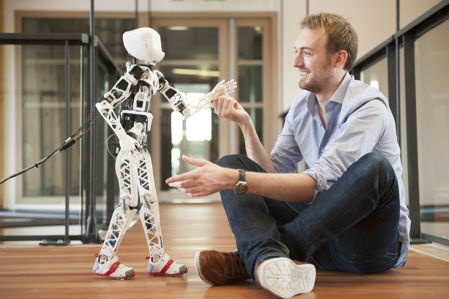
Schools in the 21st century are gradually incorporating new technologies into their curricula and educational tools. Digital and robotics do have a great deal to offer in the classroom, as they increase pupils’ motivation and help reduce inequalities and academic failure.
We interviewed Didier Roy , a researcher in the INRIA Flowers team and maths teacher, who gives his point of view in this two-part interview.
Génération Robots: Could you quickly introduce yourself, for those who don’t (yet) know you?
Didier Roy: Having started out as a
secondary school maths teacher
, I’m
now a researcher in the Flowers team at INRIA Bordeaux Sud-Ouest
. This is a developmental robotics research team that studies
development mechanisms in humans and robots
.
My area of research is the optimisation and personalisation of teaching sequences with machine learning and artificial intelligence. I’m involved in the
Kidlearn
project, which is experimenting with new algorithms for learning pathways. In addition to this work, I also do some robotics mediation to spread the word about digital sciences, especially robotics and programming.
Génération Robots: You’ve had a particularly rich career in terms of projects, training and areas of study. At what point did you realise how important a role robotics can play in schools? What was the trigger?
Didier Roy:
I’ve long been interested in teaching algorithms and IT
. Robotics is a field that has been experiencing
considerable growth
for some years now. In 2009, I began introducing pupils to robotics in a secondary school, and I quickly
noted the positive impact on pupil motivation and the acquisition of new skills
.
In 2011, I took part in the
RASPO
research project on the use of a humanoid robot for remedial work in maths.
My conviction that robotics holds terrific educational promise came about quite naturally.
Joining the Flowers research team only strengthened this conviction
, and I began thinking about creating a robotics curriculum for teaching, in particular for introducing primary school children to robotics.
I set up a working group on robotics teaching, consisting of primary and secondary school teachers and robotics researchers. The group’s members were experimenting, or wanted to, with numerous robotics-related activities in an education context.
Génération Robots: How do you persuade teachers unfamiliar with this field to join you in this adventure? What are the greatest benefits of a robotics workshop for them and their pupils?
Didier Roy: Robotics opens the door to a micro-world of motivating , entertaining learning. Establishing a link between the digital world and the physical world helps introduce pupils to a key future technology . It also creates an ideal context for playing with algorithms and programming , often considered more interesting than when faced merely with a computer screen, especially among girls.

We see groups of pupils thinking up algorithms, discussing them, programming and then testing them in an atmosphere in which they feel confident, no doubt due partially to the fact that the rewards are tangible. Whatever you do, it’s either valid or not, there can be no arguing. This physical expression of an intellectual process is both reassuring and gratifying.
From a more general point of view, if we fail to teach digital sciences, there is a risk of a gap being created between those having some knowledge, capable of understanding and taking action, and those who are left behind , more easily influenced, in a world they no longer understand.
There are also benefits in terms of learning other school subjects, especially
French, maths, sciences, the visual arts and music
. The tangible aspect of robotics helps in
developing a scientific approach
, and learning how to reason and debate.
Handling a physical object is extremely motivating
and a major additional advantage when it comes to understanding.
The co-operative aspect
that comes with the robotics activities on offer also creates a new arena to help poorly-performing pupils or those who are ill at ease in the school system to express themselves.
Génération Robots: The Inirobot module is a great success, offering workshop leaders and educators a turnkey solution for letting their pupils discover robotics. What age group would you recommend this module for?
Didier Roy: I’ll take advantage of your question to mention the possible uses of IniRobot . Use in the context of activities involving digital sciences and use in class can be very different , depending on the cultural and subject objectives . Within the same sequence of activities, you can emphasise this or that aspect, take one task further or conversely leave one out.

As far as age groups go, IniRobot is designed for use with children between 6 and 12 years , but it can also be used with other age groups . Because it is based on visual programming, even children who aren’t reading yet can do algorithmics in a robotics context. IniRobot can also be used by everyone at all ages as a fun and accessible introduction to robotics and programming.
Génération Robots: Once all the activities are completed, what in your view is the next step? On which robotics platform and using which language can children who have completed the IniRobot module start to work? What would you recommend for the older age groups?
Didier Roy: It might be an idea to begin with an introduction to digital sciences, starting with
unplugged activities with no computer or robot (see
pixees.fr
)
accessible to even the very young, then use
IniRobot
, i.e. the
Thymio robot with visual programming
, then the
Thymio robot with block programming
like that offered by the Scratch software (or its alternatives Blockly and Snap). This would make it possible to cover the primary school and the
first two years of secondary school
, for example.
Then simplified textual programming using Aseba Studio and the Thymio robot, then block and later textual programming using a robotic arm with several degrees of movement, then likewise block and later textual programming using more elaborate robots like the
Metabot robot from the Rhoban team
or the little humanoid
Poppy Mini
. For the end of secondary school and higher education, the
big brother Poppy
or the
Nao from Aldebaran Robotics
.

Of course there are other possibilities that vary in terms of price and the degree of mechanical and electronic construction you want to include in this learning. The Lego Mindstorms EV3 , Arduino -based projects and the BeeBots for very young children are also frequently-used robots that are very suitable.
The second part of this interview will be posted next week!

